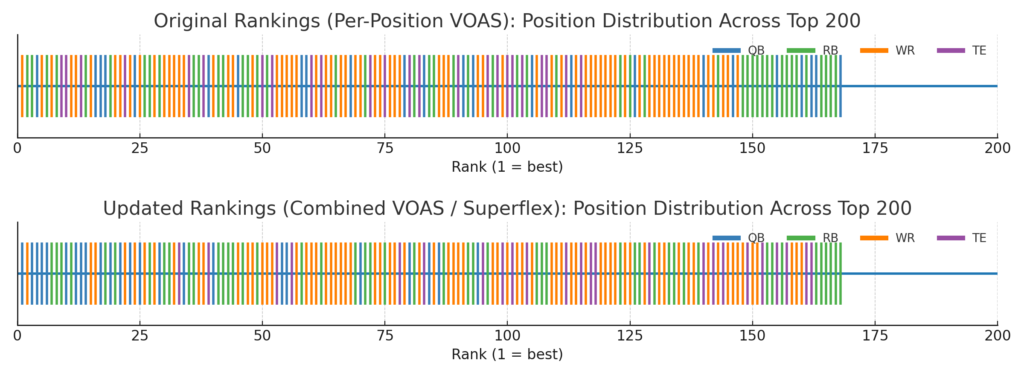Superflex Isn’t “Like” 2-QB — It Is 2-QB
Fantasy players often ask: “How should I draft in a superflex league?” The answer is simple — treat it as a 2-QB league.
Why? Because when you run the math using Value Over Average (VOA), quarterbacks dominate once you remove per-position silos. Some players intuitively treat superflex as 2-QB but others don’t take it nearly as seriously as they should. Let’s break it down.
Step 1: Understanding Value Over Average
Our traditional “Value Over Average Starter” (VOAS) rankings calculate value within each position. A WR’s value is measured against the average starting WR, a TE against the average starting TE, and so on. This is a sound method when roster spots are fixed.
But in a superflex (where the slot can be QB/RB/WR/TE), the spot doesn’t care about position. All that matters is total points scored. That means the correct baseline is not per-position, but a combined starter baseline across QB/RB/WR/TE.
Step 2: What the Data Shows
We recalculated VOAS from 2024 in two ways:
- Original per-position VOAS (baseline within each position).
- Combined VOAS (treating all QBs/RBs/WRs/TEs as one pool — the true superflex condition).
Baselines (12-team league assumptions):
- QB baseline: 345.4
- RB baseline: 257.8
- WR baseline: 233.5
- TE baseline: 194.4
- Combined baseline (superflex): 250.8
Step 3: The Visual Proof
The easiest way to see this is visually. Below, each tick represents one of the top 200 players, color-coded by position:

- Top strip (original VOAS): Positions are balanced because each is compared against its own baseline.
- Bottom strip (combined VOAS / superflex): QBs surge to the front, while TEs vanish from relevance. A lot more blue on the left, with purples moving way to the right.
This is why superflex drafts behave exactly like 2-QB drafts — the optimal play is to load up on quarterbacks.
Step 4: Position-by-Position Impact
- Quarterbacks: Average rank improvement of +88.5 spots. They flood the top of the board.
- Tight Ends: Average decline of −25.6 spots. Most become undraftable in superflex context.
- RB/WR: Smaller shifts (RB +27.8, WR +14.3), but still trail far behind QBs in superflex value.
Step 5: Flex Spot Sidebars
The same logic applies to standard flex positions:
- WR/RB/TE flex: Effectively WR/RB only. Only two TEs beat the WR/RB flex baseline.
- WR/TE flex: Effectively WR-only. Only three TEs beat the WR baseline.
Unless you have an elite outlier (Kelce, Bowers, McBride in our sample), avoid plugging TEs into flex. Let’s other people overpay for TEs and you, since you’re a Blueprint person, stick to RBs and WRs.
Step 6: Scoring Caveat
These conclusions assume standard scoring. If your league tweaks settings to normalize production (e.g., QB = 1 pt per 50 pass yards, or TE = 2 PPR while WR = 1 PPR), then positions are balanced again and pooling is fair. Always check your scoring.
Conclusion
A superflex league is a 2-QB league in disguise.
- Draft QBs early and often.
- Treat WR/RB/TE flexes as WR/RB only.
- Ignore TE in flex unless you happen to get a large ADP discount on an elite option (the delta column on your matrix cheat sheet).
Use the math, not gut feel — and you’ll always be ahead of your league.